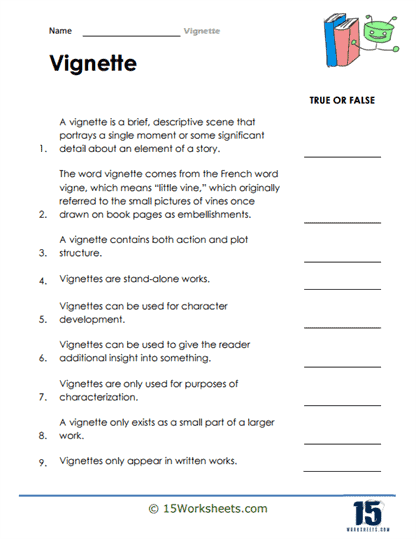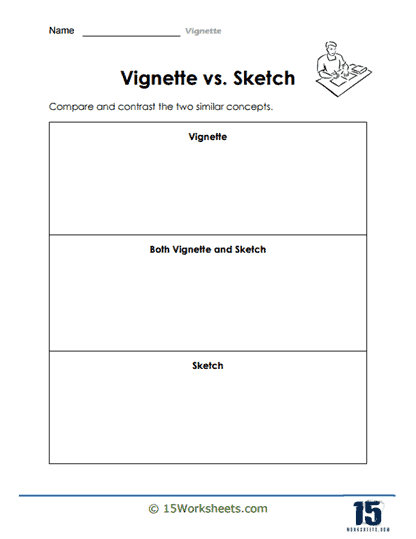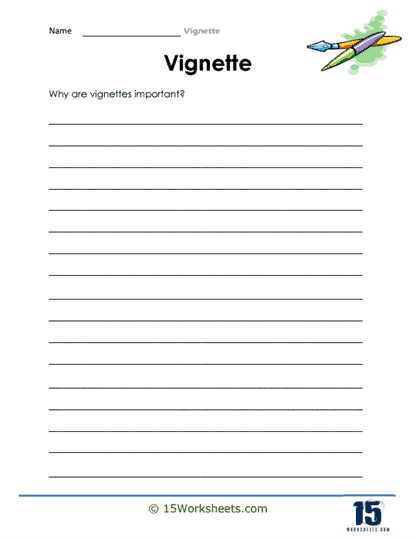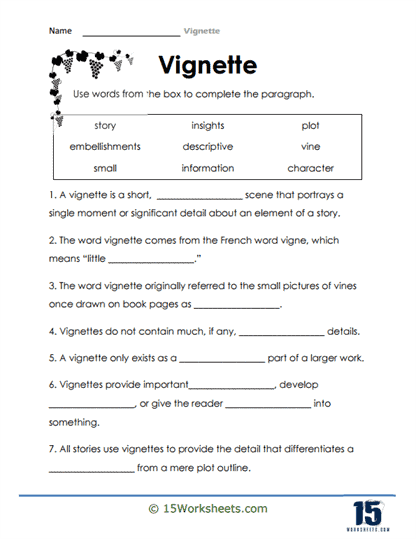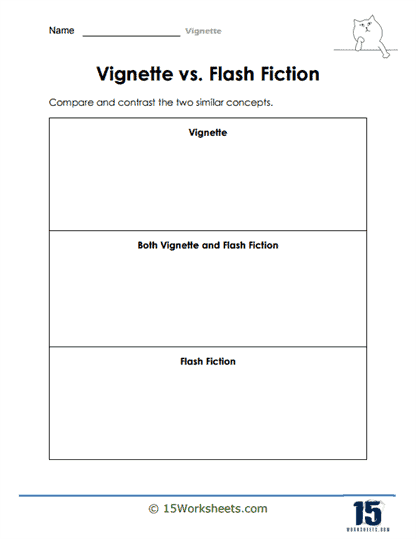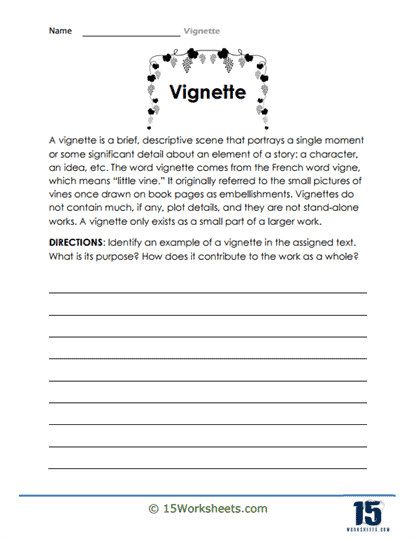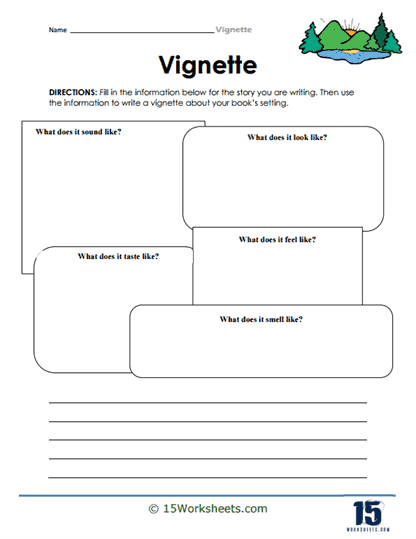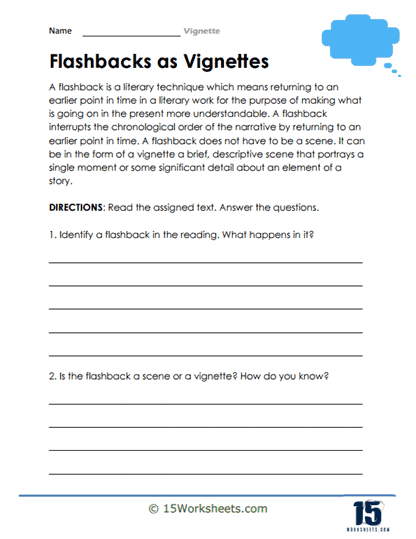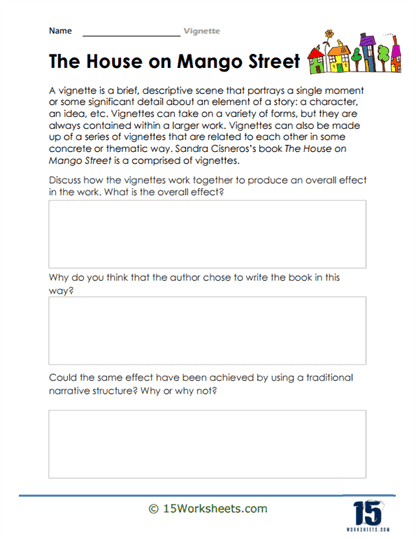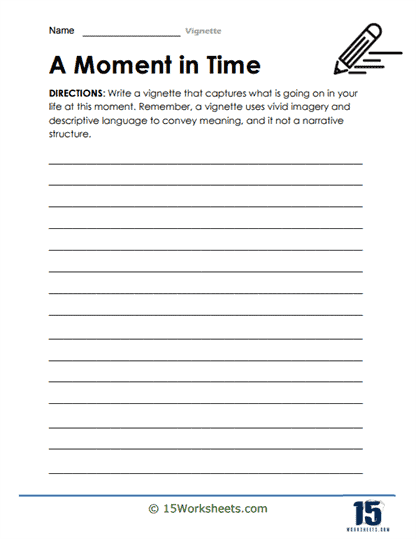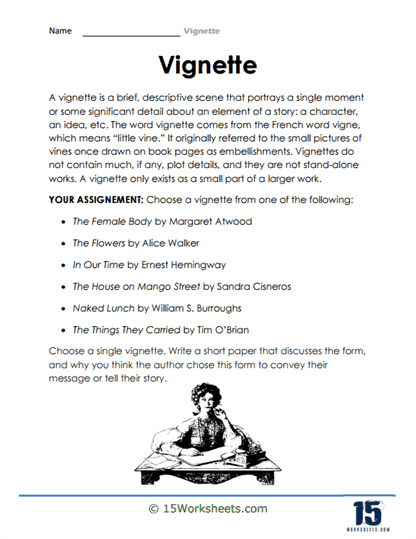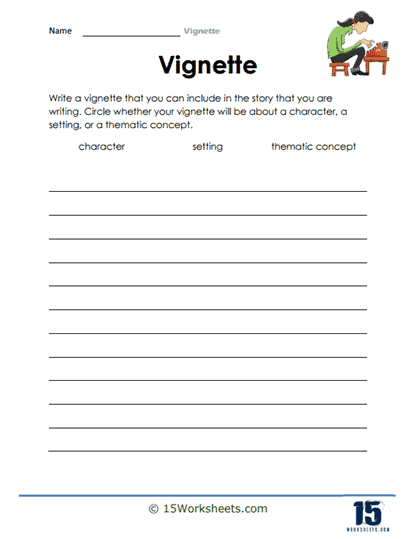Vignette Worksheets
About These 15 Worksheets
These worksheets will help to enhance student understanding of language arts by engaging them in a series of brief, focused writing and reading exercises. Each worksheet centers around a “vignette,” a short, descriptive piece of writing that captures a moment, character, or setting in precise detail. The exercises that accompany these vignettes are varied and aim to build different facets of a student’s language arts proficiency.
They not only strengthen a student’s technical abilities in reading and writing but also nurture a nuanced understanding of the power of language. Through consistent practice, students become more literate, expressive, and insightful, which are invaluable skills in academic contexts and beyond.
Types of Exercises
Comprehension Questions
These are direct questions about the vignette that test a student’s ability to understand and interpret the text. They often require the student to infer meaning, identify themes, or analyze characters, which helps to develop critical reading skills. Students may be asked to identify unfamiliar words within the vignette and use context clues to determine their meanings. This might also involve using a dictionary or thesaurus to find definitions and synonyms, which aids in vocabulary expansion.
Creative Response
In this exercise, students write their own short vignettes in response to prompts related to the original text. This encourages creative thinking and helps students to practice narrative techniques such as setting, characterization, and mood. Students are tasked with finding examples of figurative language like metaphors, similes, personification, and hyperbole. Identifying these helps students understand how language can be used in artistic ways to enhance meaning.
Grammar and Punctuation Practice
Worksheets may include exercises where students must correct or rewrite sentences from the vignette, focusing on proper grammar and punctuation. This reinforces the rules of language and the importance of editing. Some worksheets encourage group discussion on various aspects of the vignette, such as the author’s purpose, the tone, or the emotional impact. Discussion fosters deeper understanding and helps students articulate their thoughts clearly.
Literary Analysis
Students may be asked to analyze the vignette for literary devices, narrative structure, and stylistic elements, which enhances their analytical skills and deepens their appreciation for literature. These exercises focus on the development and analysis of characters within the vignette. Students might map out character traits, motivations, and growth, learning to understand character dynamics. Students explore the time and place depicted in the vignette. They may describe the setting in detail or discuss how it contributes to the overall narrative, learning the importance of context in storytelling.
Inference Skills
Many vignettes are deliberately ambiguous, encouraging students to infer meaning beyond the written words. This sharpens intuitive and deductive reasoning skills. By comparing the vignette to other texts, students learn to draw parallels and contrasts between different works. This helps them to recognize thematic patterns and narrative techniques across literature.
The Benefits of These Worksheets
Enhanced Reading Comprehension
Regular practice with vignettes allows students to become adept at understanding subtleties and complexities in text, an essential skill for higher-level reading. Vignette worksheets teach students to appreciate the craftsmanship that goes into writing, from word choice to the rhythm of sentences.
Improved Writing Skills
By writing their own vignettes, students learn to articulate thoughts concisely and vividly, improving both their creative and expository writing skills. Engagement with rich, diverse language in vignettes exposes students to new words and phrases, enhancing their vocabulary.
Critical Thinking Development
Analyzing vignettes involves reasoning and making judgments, which cultivates critical thinking abilities. Grammar and punctuation exercises refine students’ editing skills, crucial for producing polished writing. Group discussions based on vignettes enhance oral communication skills and the ability to argue points with evidence.
Confidence in Expressing Opinions
As students articulate their interpretations of vignettes, they become more confident in their viewpoints and more skilled in expressing them. Since vignettes can be windows into different times and places, they expand a student’s cultural and historical horizons. Working with vignettes helps students grasp the elements of storytelling, useful in both analyzing literature and understanding narrative structures in media.
What is the Literary Device of Vignette?
A vignette, in the realm of literary devices, is a short, descriptive passage that’s more about evoking meaning through imagery and language than about advancing the narrative. It’s like an artist’s sketch, which captures the essence of a subject rather than its explicit detail. Authors use vignettes to create an atmosphere, deepen the reader’s understanding of a character or setting, or to illuminate themes without the constraints of plot.
Main Defining Feature of a Vignette
The primary defining feature of a vignette is its brevity and focus. It doesn’t adhere to the structure of a traditional story with a clear beginning, middle, and end. Instead, a vignette zooms in on a moment, feeling, character, or place, giving the reader a glimpse into a specific aspect of the narrative world or the human experience. It’s a literary snapshot that captures a moment in time, rich with emotion, sensory detail, or both.
Characteristics of a Vignette
Imagery – Vignettes are highly visual. Authors use detailed, vivid descriptions to paint a picture in the reader’s mind, focusing on sensory experiences to bring the scene to life.
Brevity – A vignette is brief but powerful. It doesn’t include long-winded explanations or extraneous details. Each word is carefully chosen to contribute to the overall impression. Rather than moving the plot forward, vignettes often highlight the emotional landscape of the narrative. They delve into the internal world of a character or the emotional undercurrents of a setting.
Symbolism – Vignettes frequently employ symbolism. Objects, actions, or moments within a vignette often stand for larger concepts or themes.
Open-ended – Vignettes usually don’t have a clear conclusion. They’re open to interpretation, allowing the reader to continue the thread in their imagination.
Stand-alone Quality – While a vignette may be part of a larger narrative, it often possesses the quality of being able to stand alone, independent of the story in which it appears.
Examples of Vignettes in Literature
“The House on Mango Street” by Sandra Cisneros
Cisneros’ novel is a series of vignettes, each providing a snapshot of Esperanza’s coming-of-age experience in Chicago. In the vignette titled “My Name,” Cisneros uses the symbol of Esperanza’s name to explore themes of identity and cultural heritage. The name, inherited from her grandmother, is described as a “sad name, a Mexican sad name,” reflecting the weight of cultural expectations and the longing for self-definition. The vignette doesn’t resolve the tension but leaves the reader pondering the connection between names and identity.
“In Our Time” by Ernest Hemingway
Hemingway’s collection of short stories includes vignettes such as “Chapter VI,” which is a mere two paragraphs long yet encapsulates the horror of war. It describes a military execution in a neutral, detached tone, mirroring the emotional numbness of the characters. The lack of context and unresolved nature of the scene forces the reader to confront the brutality and senselessness of violence, leaving an indelible impression.
“Les Misérables” by Victor Hugo
Hugo often uses vignettes to enhance his expansive novel, such as when he dedicates passages to describe the Battle of Waterloo. Instead of advancing the story of his characters, he paints a broader picture of the battle’s historical significance and human cost. This immersion into a historical event adds depth to the narrative, allowing readers to feel the impact of these larger societal forces on the characters’ lives.
The Effect of Vignette on the Reader
Vignettes can have a profound impact on the reader. Because they focus on evocation rather than exposition, they often linger in the reader’s mind, inviting a deeper emotional response. This can be particularly effective in connecting readers to characters or settings, building empathy and understanding.
The open-ended nature of vignettes also invites the reader to engage more actively with the text. Without a clear conclusion, readers are left to ponder the significance of what they’ve just read, encouraging them to draw their own connections and conclusions. This makes the reading experience more interactive and personal.
Moreover, vignettes often distill complex themes into a single, digestible moment. This can make abstract or broad concepts more tangible and accessible. By capturing the essence of an idea in a brief, focused way, vignettes allow readers to grasp and reflect upon thematic elements at a deeper level.
Through brevity, imagery, and focused emotional resonance, vignettes deepen the reader’s engagement with the text and leave a lasting impression that often transcends the power of traditional narrative progression. They remind us that sometimes, it is the smallest moments that hold the most meaning.



